cooling PONTIAC BONNEVILLE 1996 User Guide
[x] Cancel search | Manufacturer: PONTIAC, Model Year: 1996, Model line: BONNEVILLE, Model: PONTIAC BONNEVILLE 1996Pages: 387, PDF Size: 18.71 MB
Page 225 of 387
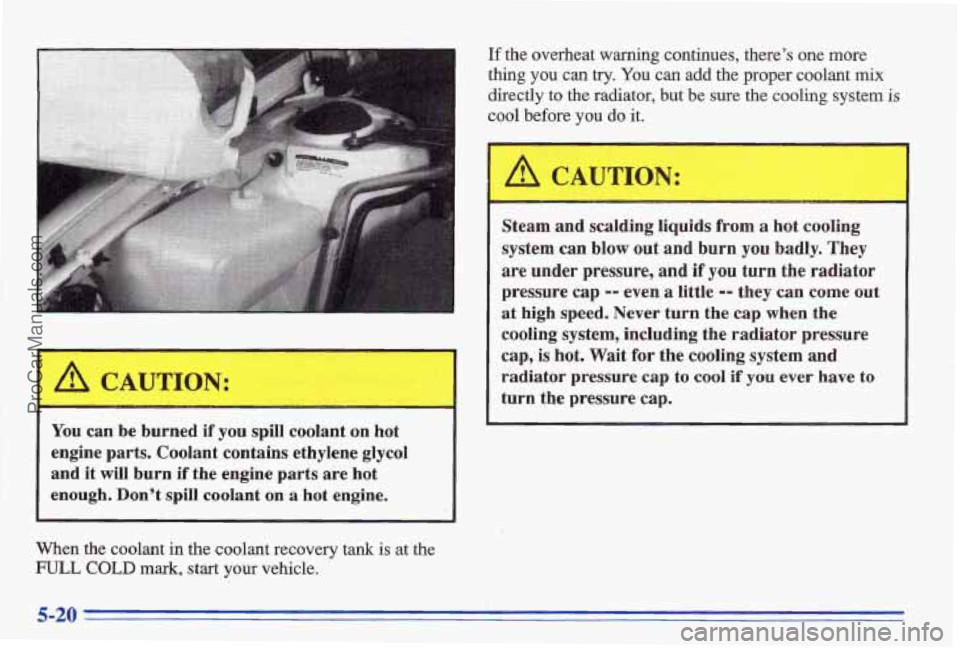
I
I A CAUTION:
If the overheat warning continues, there's one more
thing you can
try. You can add the proper coolant mix
dire'ctly to the radiator, but b'e sure the cooling system is
cool before you do it.
You can be burned if you spill coolant
on hot
engine parts. Coolant contains ethylene glycol
and it will burn
if the engine parts are hot
enough. Don't spill coolant
on a hot engine.
When the coolant
in the coolant recovery tank is at the
FULL COLD mark, start your vehicle. Steam
and scalding liquids from
a hot cooling
system can blow out and burn you badly. They
are under pressure, and if you turn the radiator
pressure cap
-- even a little -- they can come out
at high speed, Never turn the cap when the
cooling system, including the radiator pressure
cap, is
hot. Wait for the cooling system and
radiator pressure cap to cool
if you ever have to
turn the pressure cap.
5-20
ProCarManuals.com
Page 226 of 387
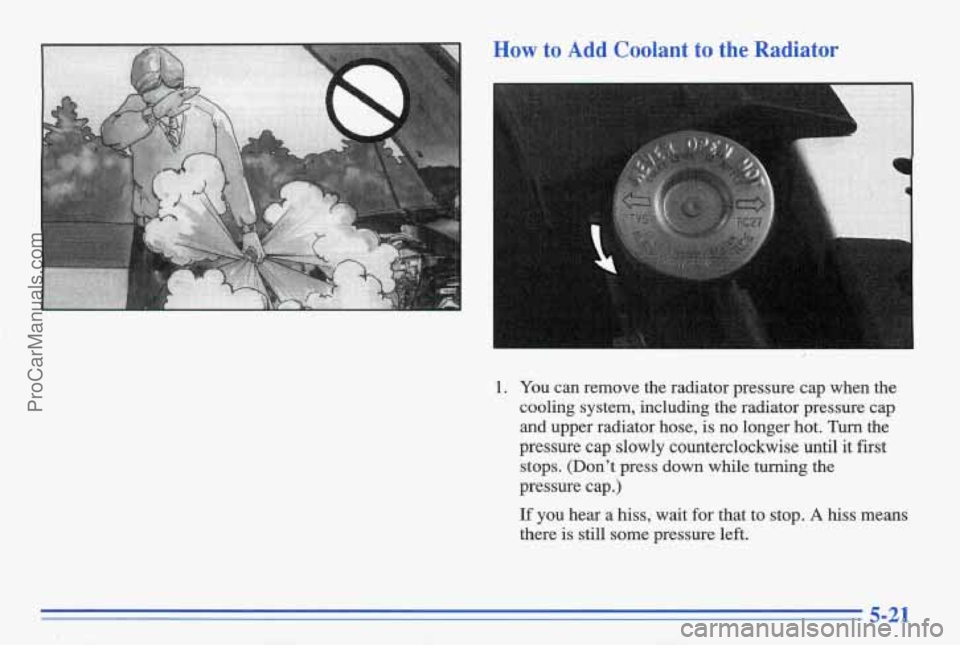
How to Add Coolant to the Radiator
1. You can remove the radiator pressure cap when the
cooling system, including the radiator pressure cap
and upper radiator hose,
is no longer hot. Turn the
pressure cap slowly counterclockwise until it first stops. (Don’t press down while turning the
pressure cap.)
If you hear a
hiss, wait for that to stop. A hiss means
there is still some pressure left.
ProCarManuals.com
Page 267 of 387
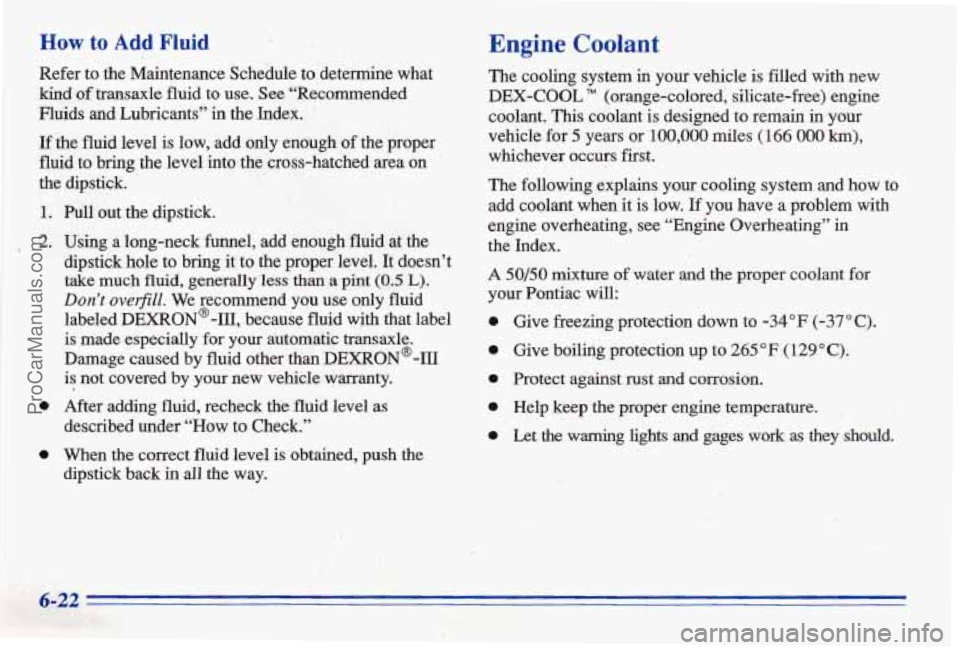
How to Add Fluid
Refer to the Maintenance Schedule to determine what
bind of tmhsaxle fluid to use. See 6‘Recomended
Fluids and Lubricants” in the Index.
If the fluid level is low, add only enough of the proper
fluid to bring
the level into the cross-hatched area on
the dipstick.
Pull out the dipstick.
Using a long-neck funnel, add enough
Md at the
dipstick hole to bring it to the proper level. It doesn’t
take much
fluid, generally less than a pint (0.5 L).
Don’t overfiI2. We recommend you use only fluid
labeled
DEXRON*-III,, because fluid with that label
is made especially for yo& automatic transax18e.
Damage caused
by fluid other than DEXRON’@-III
is not covered by your new vehicle warranty.
After adding fluid, recheck the fluid level as
described under “How to Check.”
When the correct fluid level is obtained, push the
dipstick back in
all the way.
Engine Coolant
The cooling system in your vehicle is filled with new
DEX-COOL (orange-colored,
silicate-free) engine
coolant.
This coolant is designed to remain in your
vehicle for 5 years or 100,000 miles (166 000 km),
whichever occurs first.
The following explains your cooling system and how to
add coolant when it is low.
If you have a problem with
engine overheating, see “Engine Overheating” in
the Index.
A 50/50 mixture of water &d the proper coolant for
your Pontiac will:
e
e
0
0
0
Give freezing protection down to -34°F (-37°C).
Give boiling protection up to 265 OF (1 29 O C).
Protect against rust and corrosion.
Help keep the proper engine temperature.
Let the warning lights and gages work as they should.
ProCarManuals.com
Page 268 of 387
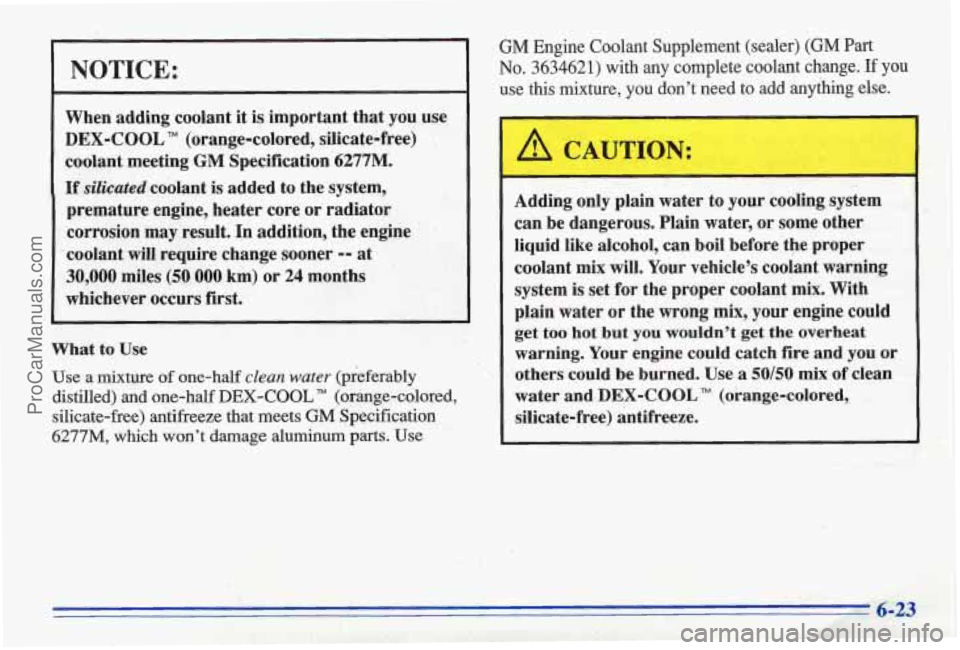
NOTICE:
When adding coolant it is important that you use
DEX-COOL TM (orange-colored, silicate-free)
coolant meeting
GM Specification 6277M.
If silicated coolant is added to the system,
premature engine, heater core or radiator
corrosion may result. In addition, the engine
’ ‘ .
-coolant will require change sooner -- at
308,000 miles (50 000 km) or 24 months
whichever occurs first.
What to Use
Use a mixture of one-half clean water (preferably
distilled) and one-half
DEX-COOL (orange-colored,
silicate-free) antifreeze that meets
GM Specification
6277M, which won’t damage aluminum parts. Use
GM Engine Coolant Supplement (sealer) (GM Part
No. 3634621) with any complete coolant change. If you
use this mixture, you don’t need to
add anything else.
L
Adding only plain water to your cooling system
can be dangerous. Plain water,
or some other
liquid like alcohol, can boil before the proper
coolant mix will. Your vehicle’s coolant warning
system is set for the proper coolant mix. With
plain water
or the wrong mix, your engine could
get too hot but you wouldn’t get
the overheat
warning. Your engine could catch fire and you or
others could
be burned. Use a 5060 mix of clean
water and
DEX-COOL TM (orange-colored,
silicate-free) antifreeze.
ProCarManuals.com
Page 269 of 387
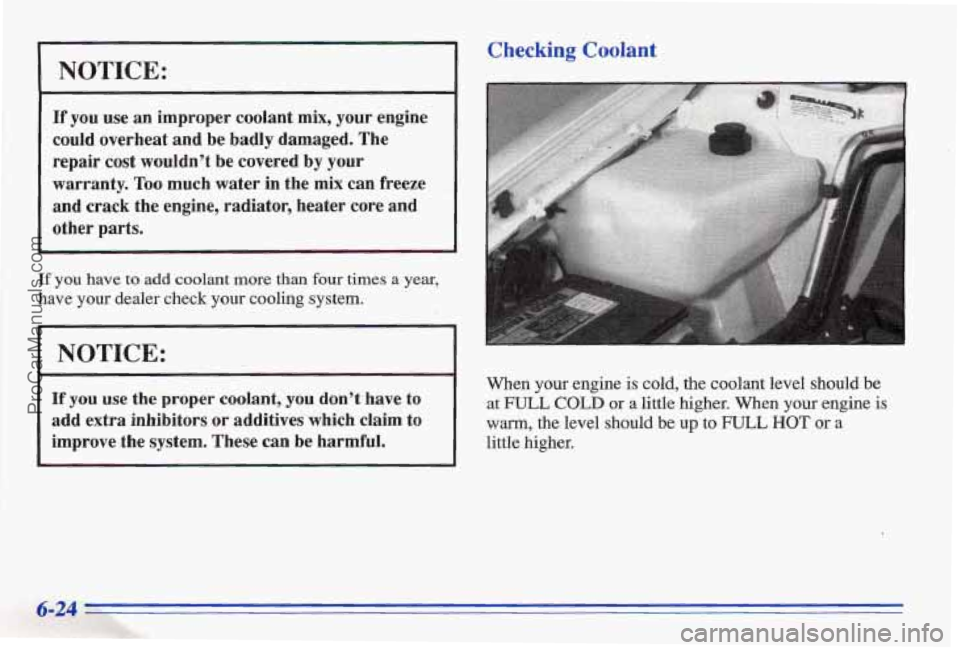
NOTICE:
If you use an improper coolant mix, your engine
could overheat and be badly damaged. The
repair
cost wouldn’t be covered by your
warranty.
Too much water in the mix can freeze
and
crack the engine, radiator, heater core and
other parts.
If you have to add coolant more than four times a year,
have your dealer check your cooling system.
NOTICE:
If YOU use the proper coolant, you don’t have to
add extra inhibitors or additives which claim to
improve .the system. These can be harmful.
Checking Coolant
When your engine is cold, the coolant level should be
at FULL COLD or a little higher. When your engine is
warm, the level should be up to FULL HOT or a
little higher.
ProCarManuals.com
Page 293 of 387
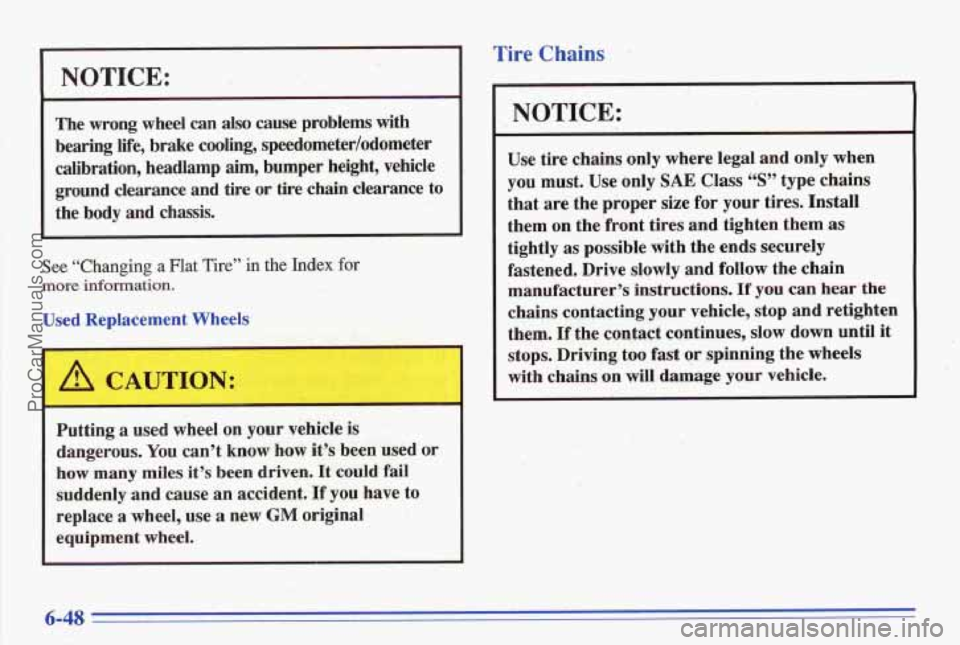
NOTICE:
The wrong wheel can also cause problems with
bearing life, brake cooling, speedometer/odometer
calibration, headlamp aim, bumper height, vehicle
ground clearance and tire or tire chain clearance to
the body and chassis.
.. -* ‘ .. ’ see “Changing a Flat Tire” in the Index for
‘more information.
.. .‘I, . .I .
.‘. -- . 8; . Putting a used wheel on your vehicle is
;. .. . dangerous. You can’t know how it’s been used or
,.; how many miles it’s been driven. It could fail
-. :% suddenly and cause an accident. If you have to
. -1 . .. I -.~ I., .<.
.. ?1 :: :. <.. >. - ., 3
I .) .
,,.. ‘,,‘t, . .?. I
.: replace a wheel, use a new GM original
.I , . ..
., , equipment wheel. -.
-. ., ..
I
Tire Chains
NOTICE:
Use tire chains only where legal and only when
you must. Use only
SAE Class 44S” type chains
that are the proper size for
your tires. Install
them on the front tires and tighten them as
tightly as possible with the ends securely
fastened. Drive slowly and follow the chain
manufacturer’s instructions.
If you can hear the
chains contacting
your vehicle, stop and retighten
them.
If the contact continues, slow down until it
stops. Driving too fast or spinning the wheels
with chains on will damage your vehicle.
* “
ProCarManuals.com
Page 306 of 387
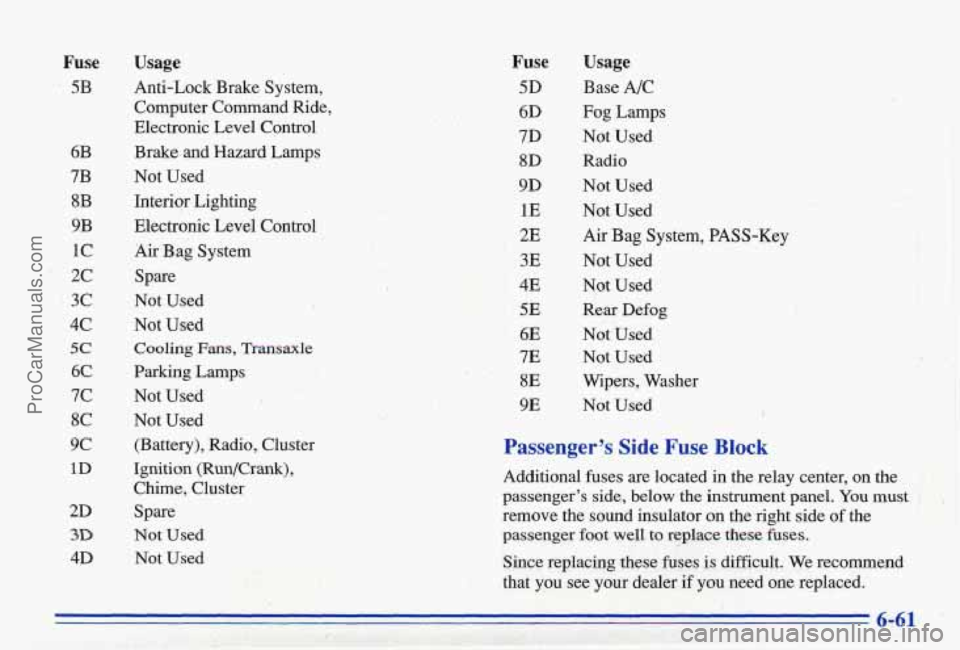
Fuse
5B
6B
7B 8B
9B
1c
2c
3c
4,c
5c
6C
7c
8C
9c
1D
2D
3D
4D
Usage
Anti-Lock Brake System, Computer Command Ride,
Electronic Level Control
Brake and Hazard Lamps
Not Used
Interior
I Lighting
Electronic Level Control
Air Bag System
Spare
Not Used
Not Used
Cooling Fans, Trmsmle
Parking Lamps
Not Used
Not Used (Battery), Radio, Cluster
Ignition (Run/Crank), Chime, Cluster
Spare
Not Used Not Used
Fuse
5D
6D
7D 8D
9D
1E
2E
3E
4E
5E
6E
7E
8E
9E
Usage
Base A/C
Fog Lamps
Not Used Radio
Not Used Not Used
Air Bag System, PASS-Key
Not Used
Not Used
Rear Defog
Not Used
Not Used
Wipers, Washer
Not Used
I
Passenger% Side Fuse Block
Additional fuses are located in the relay center, on the
passenger's side, below the instrument panel.
You must
.. : i',
.- . '! i . -." remove the sound insulator on the right side of the
>. passenger foot well to replace these fbses.
Since replacing these fuses is difficult. We recommend
that you see your dealer
if you need me replaced.
ProCarManuals.com
Page 310 of 387
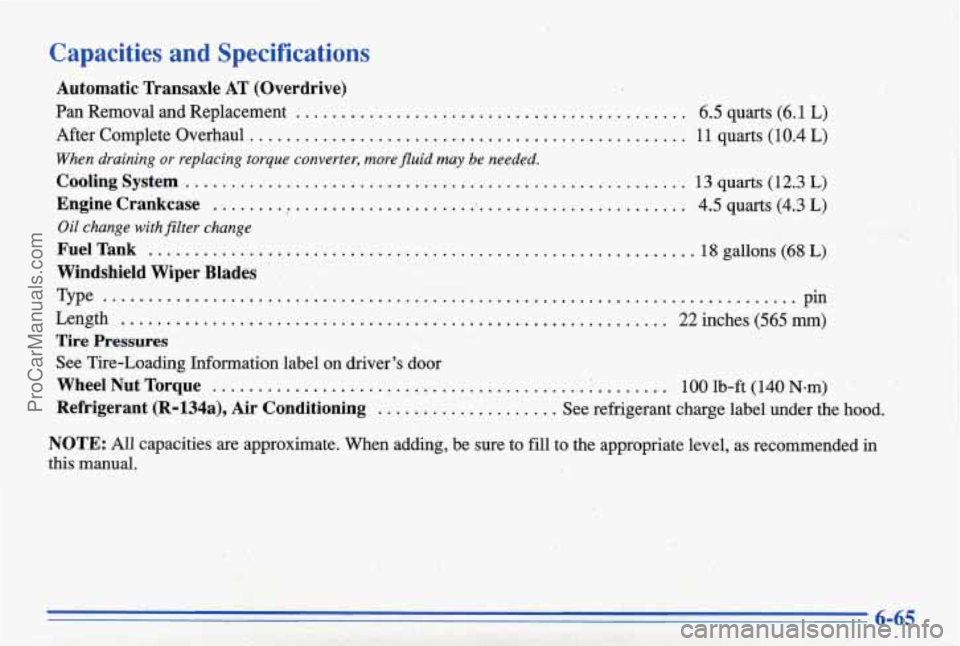
Capacities and Specifications
Automatic Transaxle AT (Overdrive)
Pan Removal and Replacement .... '. ......................................
After Complete Overhaul ................................................
When draining or replacing torque converter, more fluid may be needed.
CoolingSystem .......................................................
Enginecrankcase .....................................................
Oil change with filter change
FuelTank .........................................
Windshield Wiper Blades
Type ..............................................
..
..
...
...
6.5 quarts (6.1 L)
11 quarts (10.4 L)
13 quarts (12.3 L)
4.5 quarts (4.3 L)
..
..
............ 18 gallons (68 L)
....................... Pin
Length
............................................................ 22 inches (565 mm)
Tire Pressures
See Tire-Loading Information label on driver's door
WheelNutTorque ......................................... ;........ lOOlb-ft(140N~m)
Refrigerant (R=l34a), Air Conditioning .................... See refrigerant charge label under the hood.
ProCarManuals.com
Page 319 of 387
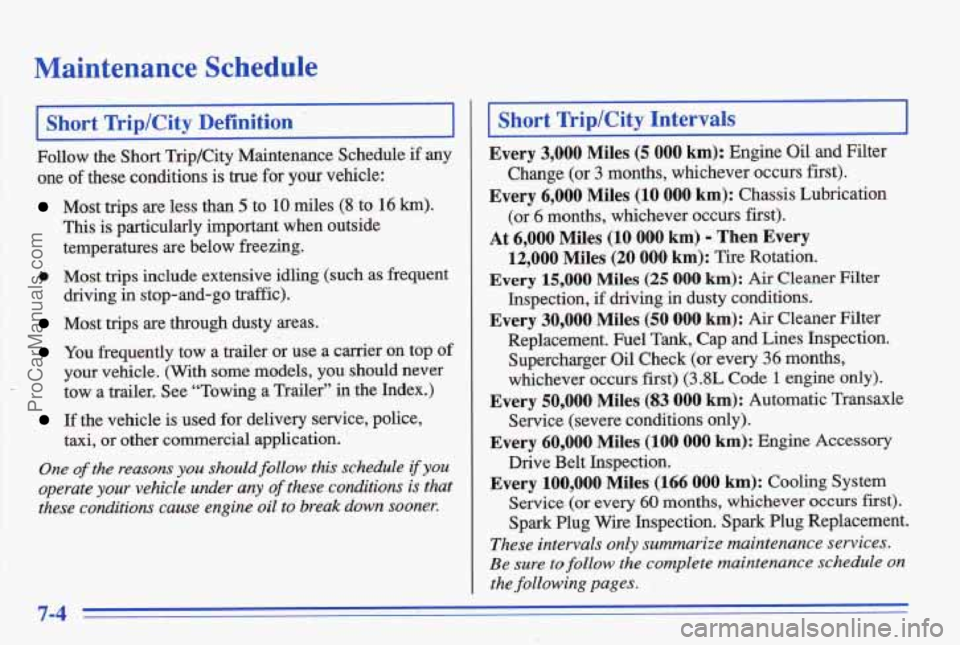
Maintenance Schedule
I Short Trip/City Definition
Follow the Short Trip/City Maintenance Schedule if my
one of these conditions is true for your vehicle:
Most trips are less than 5 to 10 miles (8 to 16 h).
This is particularly important when outside
temperatures
are below freezing.
I
Most trips are through dusty areas.
You frequently tow a trailer QT use a carrier on top of
your vehicle. (With some models, you should never
tow a trailer. See “Towing
a Trailer” in the Index.)
taxi, or other commercial application.
If the vehicle is used for delivery service, police,
One of the reasom you should follow this schedule if you
operate your vehicle under any of these conditions is that
these conditions cause engine
oil to break down suoner.
Short Trip/City Intervals
Every 3,000 Miles (5 000 km): Engine Oil and Filter
Change (or 3 months, whichever occurs first).
Every 6,000 Miles (10 000 km): Chassis Lubrication
(or
6 months, whichever occurs first).
At 6,000 Miles (10 000 km) - Then Every
12,000 Miles (20 000 km): Tire Rotation.
Every 15,000 Miles (25 000 km): Air- Cleaner Filter
Inspection, if driving in dusty conditions.
Every 30,000 Miles (50 000 km): Air Cleaner Filter
Replacement Fuel
Tank, Cap and Lines Inspection.
Supercharger
Oil Check (or’every 36 months,
whichever occurs first)
(3.8L Code 1 engine only).
Every 50,000 Miles (83 000 h): Automatic Tramaxle
Service
(severe conditiom only).
Every 60,000 Miles (I00 000 km): Engine Accessory
Drive Belt Inspection,
Every 100,000 Miles (166 000 km): Cooling System
Service
(or every 60 months, whichever.occurs fist).
Spark Plug Wire Inspection. Spark Plug Replacement.
These intervals only summarize maintenance services.
Be sure to follow the comglbte maintenance schedule on
the following pages.
7-4
ProCarManuals.com
Page 320 of 387
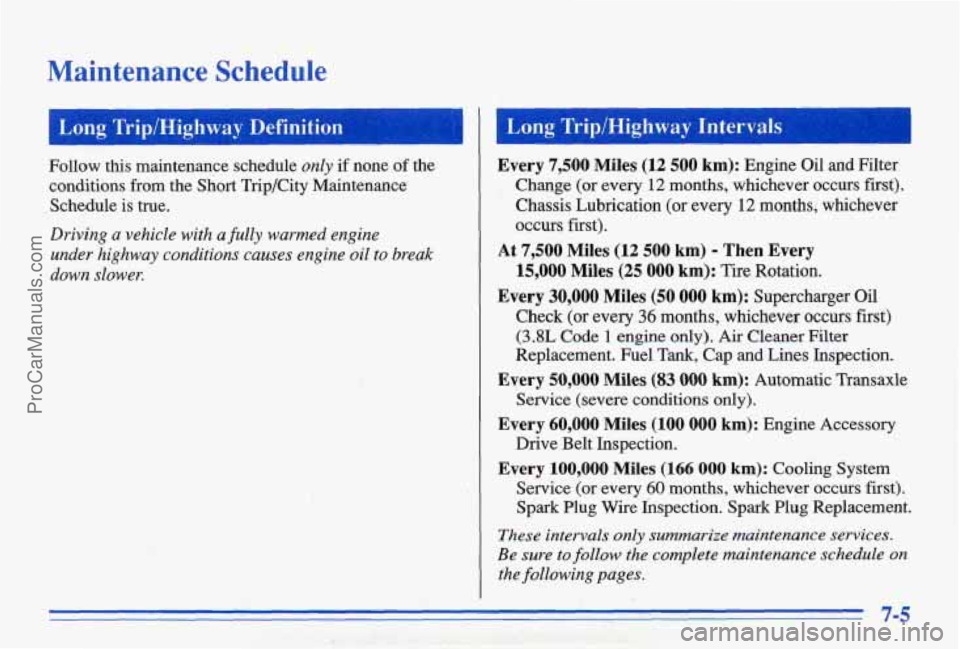
Maintenance Schedule
Follow this maintenance schedule only if none 01 the
conditions from
the Short Trip/City Maintenance
Schedule is true.
Driving a vehicle with a fully warmed engine
under highway conditions causes engine
oil to break
down slower.
Every 7,500 Miles (12 500 km): Engine Oil and Filter
Change
(or every 12 months, whichever occurs first).
Chassis Lubrication (or every
12 months, whichever
occurs
first).
At 7,500 Miles (12 500 km) - Then Every
15,000 Miles (25 000 km): Tire Rotation.
Every 30,000 Miles (50 000 km): Supercharger Oil
Check (or every
36 months, whichever occurs first)
(3.8L Code 1 engine only). Air Cleaner Filter
Replacement. Fuel Tank, Cap and Lines Inspection.
Every 50,000 Miles (83 000 km): Automatic Transaxle
Service (severe conditions only).
Every 60,000 Miles (100 000 km): Engine Accessory
Drive Belt Inspection.
Every 100,000 Miles (166 000 km): Cooling System
Service (or every
60 months, whichever occurs first).
Spark Plug Wire Inspection.
Spark Plug Replacement.
These intervals only summarize maintenance services.
Be sure to
follow the complete maintenance schedule on
the following pages.
7-5
ProCarManuals.com